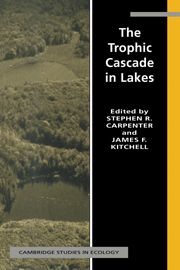Book contents
- Frontmatter
- Contents
- Contributors
- Preface
- 1 Cascading trophic interactions
- 2 Experimental lakes, manipulations and measurements
- 3 Statistical analysis of the ecosystem experiments
- 4 The fish populations
- 5 Fish behavioral and community responses to manipulation
- 6 Roles of fish predation: piscivory and planktivory
- 7 Dynamics of the phantom midge: implications for zooplankton
- 8 Zooplankton community dynamics
- 9 Effects of predators and food supply on diel vertical migration of Daphnia
- 10 Zooplankton biomass and body size
- 11 Phytoplankton community dynamics
- 12 Metalimnetic phytoplankton dynamics
- 13 Primary production and its interactions with nutrients and light transmission
- 14 Heterotrophic microbial processes
- 15 Annual fossil records of food-web manipulation
- 16 Simulation models of the trophic cascade: predictions and evaluations
- 17 Synthesis and new directions
- References
- Index
14 - Heterotrophic microbial processes
Published online by Cambridge University Press: 06 August 2010
- Frontmatter
- Contents
- Contributors
- Preface
- 1 Cascading trophic interactions
- 2 Experimental lakes, manipulations and measurements
- 3 Statistical analysis of the ecosystem experiments
- 4 The fish populations
- 5 Fish behavioral and community responses to manipulation
- 6 Roles of fish predation: piscivory and planktivory
- 7 Dynamics of the phantom midge: implications for zooplankton
- 8 Zooplankton community dynamics
- 9 Effects of predators and food supply on diel vertical migration of Daphnia
- 10 Zooplankton biomass and body size
- 11 Phytoplankton community dynamics
- 12 Metalimnetic phytoplankton dynamics
- 13 Primary production and its interactions with nutrients and light transmission
- 14 Heterotrophic microbial processes
- 15 Annual fossil records of food-web manipulation
- 16 Simulation models of the trophic cascade: predictions and evaluations
- 17 Synthesis and new directions
- References
- Index
Summary
Introduction
Heterotrophic microorganisms, here defined as bacteria and protozoa, account for a major portion of secondary production and nutrient remineralization in aquatic ecosystems (Stockner & Porter, 1988; Sherr & Sherr, 1991). These organisms are potentially regulated by both their predators and by the supply of organic carbon and inorganic nutrients. In general, prior studies of the trophic cascade have not considered heterotrophic microbial processes (e.g. Carpenter et al., 1987; McQueen et al., 1989; Benndorf, 1990; but see Riemann & Søndergaard, 1986). In previous chapters of this volume, the significance of cascading trophic interactions in determining the structure of zooplankton communities and in explaining shifts in phytoplankton biomass and primary production has been demonstrated. In this chapter, I consider the question, are heterotrophic microbes and the biogeochemical processes mediated by them strongly influenced by these same top-down controls?
One difficulty in answering this question arises from uncertainty about the trophic interactions and recycling processes connecting heterotrophic microbes with phytoplankton, zooplankton and fish. It is an oversimplification to consider the heterotrophic microbial food web as a separate ‘loop’ wherein bacteria utilize dissolved organic matter and are consumed by protozoa, with energy and nutrients there by returned to the phytoplankton–zooplankton–fish food chain (Azam et al., 1983). Rather, a more current view of microbial food webs is one of a complex interacting community including phytoplankton, bacteria and protozoans that collectively accounts for primary carbon fixation, nutrient regeneration and production to support metazoans (Sherr & Sherr, 1991).
- Type
- Chapter
- Information
- The Trophic Cascade in Lakes , pp. 252 - 277Publisher: Cambridge University PressPrint publication year: 1993
- 18
- Cited by



